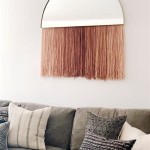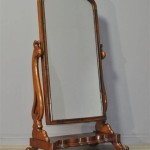How To Hang a Round Mirror With Wire
Hanging a round mirror securely and aesthetically pleasing requires careful planning and execution. This guide provides a step-by-step approach to hanging a round mirror using wire, ensuring a stable and visually appealing result.
Assessing the Mirror and Wall: Before beginning, one must evaluate both the mirror and the intended wall space. Consider the mirror's weight and dimensions. Heavier mirrors will require more robust hanging hardware and potentially different anchoring techniques. Examine the wall material; drywall requires different anchors than brick or concrete.
Gathering Necessary Materials: Proper tools and materials are crucial for a successful installation. These include a measuring tape, a pencil, a level, a drill (with appropriate drill bits for the wall type), wall anchors (if necessary), screws, D-ring hangers or a wire hanging kit specifically designed for mirrors, picture wire, and wire cutters.
Installing D-Rings or a Wire Hanging Kit: D-rings offer a reliable method for hanging heavier mirrors. Position the D-rings equidistant from the center point on the back of the mirror and an equal distance from the top edge. Mark the locations carefully with a pencil. If using a wire hanging kit, follow the manufacturer's instructions for placement. Pre-drill pilot holes at the marked locations to prevent the mirror's backing from splitting. Secure the D-rings or hanging kit components with the provided screws.
Attaching the Wire: If using D-rings, cut a length of picture wire approximately twice the width of the mirror, plus an additional 12 inches. Thread one end of the wire through the first D-ring, wrapping it around itself several times to secure it. Repeat this process with the other end of the wire and the second D-ring. The wire should form a gentle curve when held taut between the D-rings. For pre-made wire hanging kits, follow the manufacturer's instructions for attaching the wire to the kit's components.
Locating the Wall Stud (Optional but Recommended): Locating a wall stud provides the most secure anchoring point, especially for heavier mirrors. Use a stud finder to identify the center of the nearest stud to the desired hanging location. Mark this location with a pencil.
Marking the Wall for the Hanging Hardware: Measure the distance between the top edge of the mirror and the wire when it is taut. This measurement determines the placement of the wall anchor or screw. On the wall, measure down from the desired hanging height (the center of the mirror) this same distance. Mark this point with a pencil. If using a stud, align this mark with the center of the stud. If no stud is available at the desired location, proceed with the installation of a wall anchor.
Installing the Wall Anchor (If Necessary): If a wall stud is not available, select an appropriate wall anchor based on the mirror's weight and the wall material. Follow the manufacturer’s instructions for installing the anchor. Ensure the anchor is flush with the wall surface.
Installing the Wall Hook or Screw: If hanging from a stud, insert a screw directly into the marked location. Ensure the screw extends far enough from the wall to accommodate the wire. If using a wall anchor, select a screw appropriate for the anchor type and insert it into the anchor. Ensure the screw head protrudes sufficiently to catch the wire securely.
Hanging the Mirror: Carefully lift the mirror and position the wire over the installed hook or screw. Ensure the wire is centered and balanced. Gently release the mirror and check for stability.
Leveling and Adjusting: Use a level to ensure the mirror hangs straight. If adjustments are needed, gently shift the mirror until it is perfectly level. If the mirror is significantly off-center, the wall hardware may need to be repositioned.
Final Checks: After leveling, tug gently on the mirror to ensure it is securely attached. Visually inspect the installation to confirm the mirror is hanging at the desired height and position.
Considerations for Different Wall Materials: Different wall materials necessitate specific hardware. Drywall typically requires wall anchors for heavier mirrors. For brick or concrete walls, one may require specialized masonry drill bits and anchors. Consult a hardware professional for guidance if unsure about the appropriate hardware for a specific wall type.
Safety Precautions: When working with power tools, always wear appropriate safety glasses. Handle heavy mirrors with care and enlist assistance if necessary. When working at heights, use a stable step stool or ladder.
Alternative Hanging Methods: While D-rings and wire provide a traditional and reliable hanging method, other options are available. Some mirrors may have pre-installed keyhole hangers or cleats, which require different installation procedures. Always consult the manufacturer’s instructions for the specific mirror being hung.

How To Hang A Mirror With Wire Pictures Wikihow

Diy Rope Mirror

How To Hang A Heavy Mirror Or Picture True Value

How To Hang A Mirror Simple Guide

How To Hang A Mirror

How To Adjust A Mirror Art Or Picture Hanging Wire

How To Hang A Stockholm Mirror 13 Steps With Pictures Wikihow

How To Hang A Mirror With Wire Pictures Wikihow

Easy Diy Stick Framed Mirror That Looks Expensive

How To Install Wire On Back Of Mirror








